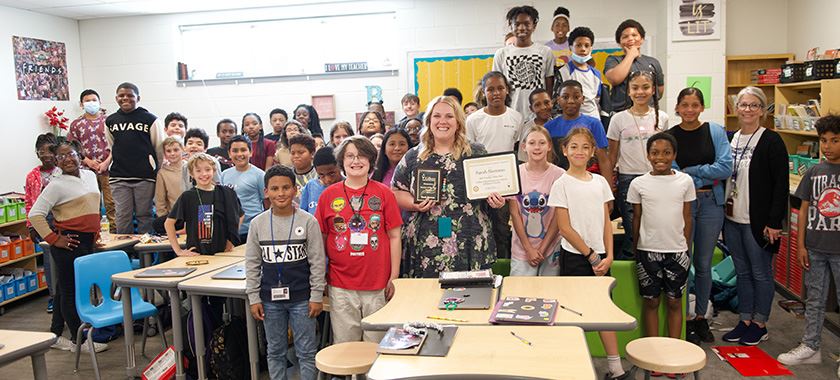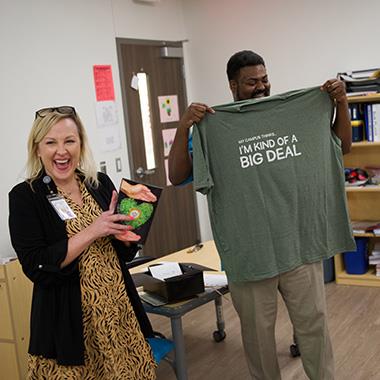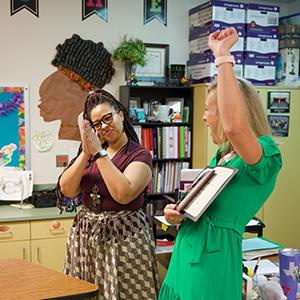- Nolan Middle School
- Homepage
Teacher of the Year Finalists Celebrated in Surprise Deliveries



To begin Killeen ISD’s annual Teacher of the Year celebration, district leaders surprised finalists on their campuses Wednesday traveling to 10 schools in two groups.
After announcing the six elementary finalists and the four secondary finalists selected from the district’s 52 campus teachers of the year, education leaders are poised to reveal KISD’s two teachers of the year.
Be on the lookout for the exciting announcement on the KISD website and social media platforms. It’s going to be soon.
Executive Directors for Elementary Schools Carrie Parker and Iris Felder joined principals and other campus leaders at six elementary schools, surprising this year’s half-dozen runners-up in the teacher of the year process.
Executive Directors for Secondary Schools Mike Quinn and Dagmar Harris visited four secondary schools, along with campus leaders, to surprise those finalists.

This year’s elementary finalists are:
Michelle DeWees, Saegert Elementary, is a fifth grade teacher with five years’ experience, all in KISD. She worked as a government auditor 13 years before entering the teaching profession.
She recalled a game she used modeled on Connect Four where student teams worked together to come up with answers. “Students of all backgrounds and abilities were able to learn through inspiration and collaboration with one another,” she explained.
“The instructional decisions of this lesson align with my beliefs of teaching the whole child. Students were responsible for articulating their knowledge of figurative language while also working as a team, exercising good sportsmanship, and learning the value of listening for understanding.”

Antoinette Yuille, Brookhaven Elementary, teaches fifth grade. She has 15 years’ experience and is finishing her seventh year in KISD.
When Yuille noticed many of her students lacked confidence in reading and writing, she adapted a lesson that minimized spelling, grammar and writing legibly.
“I noticed one student creating a Venn diagram to demonstrate her understanding. She asked if it was acceptable to draw it out instead of writing a paragraph and I replied that it was OK as long as she responded to the prompt…I was pleasantly surprised that each of my students demonstrated a strong understanding of the concept. There was no need for a reteach or review,” she explained.
Omar Esson, Fowler Elementary, is a second grade DAEP teacher finishing his second year in the classroom. He has worked in a variety of fields in Jamaica and later managing sales for a company in Killeen eight years.
“Collaboration is where the bulk of the time is spent during any lesson in my classroom. Students may be given task cards or handouts with a problem on it. As students decipher the questions and apply their analytical skills to problem solving my role becomes the facilitator. I typically observe the groups and or partners as they are working together. I may pull individual students or small groups based on my observation if it requires reinforcing a concept.”
Sarah Barnum, Clifton Park Elementary, teaches fifth grade and has 11 years’ experience, six years in KISD.
Known for many creative, engaging lessons, Barnum said it is a novel study that follows the experience of three preteens experiencing various oppression and hardship at different points in history. “They get excited to talk about the many challenges each character faces on the water, like when Mahmoud’s boat capsizes or Ivan is bitten by a shark,” Barnum explained. “They notice how the stress in the characters’ lives causes conflict between characters.”

“Students who may typically be categorized as below grade-level in reading are able to dig deep into these concepts because of their engagement with the book. Each year, I get so excited to see a student who came to me hating to read desire to borrow this book each night and read it on their own. “
Noris Garagate, Cavazos Elementary, teaches in an inclusion classroom. She has 13 years’ teaching experience, 5 in KISD. Responding to written questions, Garagate shared a memorable activity she planned that brought an “unofficial Special Olympics” event to her school.
“The students showed a lot of growth, demonstrated courage, and a sense of accomplishment. I learned so much from my students throughout the process. I felt the event also demonstrated that when students are provided with just the right tools, resources, and support; they can overcome their own individual obstacles and grow as learners. Experiences such as these offer them that invaluable feeling of success and personal value,” she wrote.
Calvin Payno, Carney Elementary served in the U.S. Army before joining the teaching ranks, where he has taught in special education three years.
Payno shared a touching and telling story of one of his fifth-grade students who stubbornly refused to learn the alphabet. In talking with the student, the soldier-turned-teacher learned that the student loved a particular cartoon.
So, the creative teacher began to connect letters to characters in the cartoon.

“The student would now tell me information about each character as we went through the alphabet. This allowed me to go over the entire alphabet three or four times in one sitting that lasted upwards of 45 minutes,” he said.
“The more we worked together the better we understood each other which made my teaching and his learning easier. This whole process took roughly 16 weeks, but it was worth it when the student was able to identify all 26 upper- and lower-case letters and received his prize.”
The secondary finalists are:
Shatira Harris, Palo Alto Middle School, was an aide in KISD 12 years and has been an ELA teacher two years. She is a 2003 Shoemaker High School graduate.
She shared a powerful lesson that challenged students to tell their personal stories. Drawing from a novel about a student navigating family tension and bullying at school, Harris discovered through an anonymous poll that every student in her class had experienced bullying.
“My next step was to have my students write a letter to their bully and all that they wanted to say to defend themselves. I assured them their response would not be read aloud, nor taken up for a grade or my personal viewing. As they wrote, the room grew quiet, pencil to paper was all that was heard. The concentration and thought processes were riveting. You could see the various states of emotions being poured out on the paper.”

Next, Harris instructed the students to read their letter silently and then shred the paper. “As every paper tore, the room was filled with such relief that was evidently felt in their entire being. Some students even shed tears of relief.”
Sarah Crawford, Career Center agriculture teacher, has 20 years’ teaching experience, all in KISD.
“I fundamentally believe that when teaching livestock reproduction, it is impossible not to see the divine planning and organization that is the continuation of the species,” she explained.

“We finish the reproduction unit with learning to artificially inseminate cows using a Realityworks ® simulator, a reproductive technology vital to the beef industry. Students are required to successfully pass an insemination rod through the cervix of a cow without injury to my simulator.”
“Year after year, this lesson has proved to have the most impact and engagement, with students returning after their first year of college, telling me that my class and this lesson more than prepared them for freshman animal science. “
Angela Elliott, Audie Murphy Middle School, is finishing her ninth year as an educator in KISD. She was an elementary teacher, an assistant principal, a secondary teacher and is finishing her first year as a PE teacher and middle school athletic coordinator.
She described a favorite lesson called “Cone Reaction” that challenges students to follow directions to respond with specific movements while working with a partner.
“By having students of all learning styles and backgrounds function in an inclusive manner on their physical level it is not only important to me; it is also what fellow peers want and expect during any of our lessons,” she wrote.

Jimmy Hammond, Killeen High School, was a military and civilian law enforcement officer almost 30 years before beginning his teaching career in 2017, sharing his expertise in law enforcement.
“I loved my profession as a practitioner, and now I get to go to work every day and share that love with my students,” the law enforcement teacher wrote.
He described his excitement teaching the first Principles of Law and Public Safety Careers course, introducing first-year students to the basics of the profession.
“It also allows us to confront the hard questions about the history of policing in America, the good, the bad, and the very ugly. I take a very honest approach to teach that history because students have to know that they are heard, and someone is not afraid to confront where police get it wrong. Once the kids see that, relationships begin to build, and barriers come down.”

